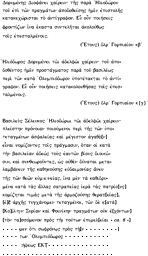Exhibited at The Israel Museum, Jerusalem, on long term loan from Michael and Judy Steinhardt, New York. Photo: The Israel Museum, Jerusalem/Peter Lanyi. Courtesy of and with thanks to the Israel Museum.
This is the upper half of a limestone stele inscribed in Greek with a copy of correspondence between King Seleucus IV (187-175 B.C.E.) and his officials. It probably stood in the sanctuary of a polis or village in this region. The stele preserves three letters, arranged from top to bottom in reverse chronological order. The king's letter, of which only the opening remains, is at the bottom of the stone and represents the earliest of the three missives. Those above it were written within a period of a few days of each other in August 178 B.C.E. In his letter, the king informs his viceroy Heliodorus, who is "in charge of affairs", of his decision to appoint an overseer of the sanctuaries in the satrapy (province) of Koilē Syria [Coele-Syria] and Phoinikē [Phoenecia], a territory encompassing the land of Israel. Heliodorus, in turn, conveys this decision to his subordinates.
Heliodorus, revealed here as an actual historical figure, is well known from the dramatic episode in the Second Book of Maccabees, written by Jews in the mid-2nd century B.C.E. According to the account, King Seleucus IV sent Heliodorus to confiscate funds deposited in the treasury of the Temple in Jerusalem. Heliodorus's attempt to seize the funds was foiled by the miraculous appearance of a horseman in shining armor assisted by two strong youths, who beat the viceroy senseless. Heliodorus' life was spared only through the intervention of the high priest Onias III.
The story, an outstanding example of divine intervention in human destiny, was immortalized by Raphael in 1511-1512 in a fresco painted on the walls of the Apostolic Palace in the Vatican. The inscription provides important information on the workings of the Seleucid Empire in this region, this time from the Seleucid perspective: The King intended to bring the satrapy of Koilē - Syria and Phoinikē - into line with the rest of the empire by appointing an overseer of the sanctuaries - among them, the Temple in Jerusalem. The position presumably included authority over the sanctuaries' funds, above all taxes due to the king. It is likely that the Jews regarded this appointment as an infringement of Jewish religious autonomy, granted them by Seleucus's predecessor, Antiochus III. Thus the dramatic episode described in 2 Maccabees may represent a subjective reworking of the historical event from an internal Jewish perspective. The appointment may also mark the beginning of a process of Greek/Seleucid interference in Jewish religious affairs, which culminated in the decrees of Antiochus IV Epiphanes and would result in the outbreak of the Maccabean revolt a decade later, in 168 B.C.E.

